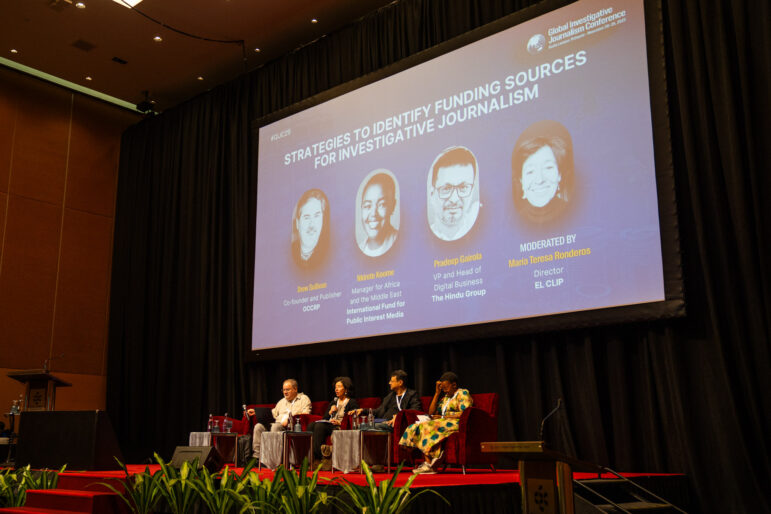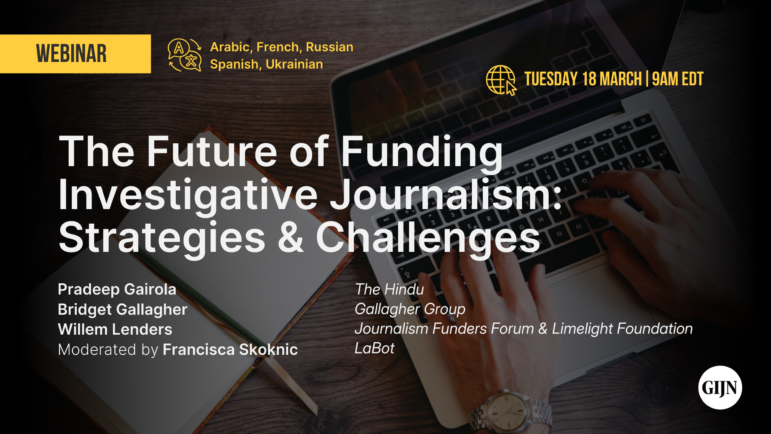

The Identifying Funding Strategies for Investigative Journalism panel at GIJC25. Image: Zahid Hassan for GIJN
This past year was cataclysmic for independent nonprofit media funding following the dismantling of USAID and donor intimidation by populist governments. And experts warn that 2026 will likely be even worse for traditional funding sources.
As a result, they urge nonprofit investigative outlets in the near term to be laser-focused on audience engagement, out-of-the-box creative solutions, and clear communications to potential donors about their organization’s unique value to the public and democracy. And they need to “stop leaving money on the table” by failing to connect (and promote) their work to the impacts it produces. These were among the key takeaways at the “Strategies to Identify Funding Sources for Investigative Journalism” panel at the 14th Global Investigative Journalism Conference (GIJC25) in Malaysia.
Because donors are now well aware of the erosion of democratic institutions and human rights norms around the world, an opportunity exists for investigative newsrooms to credibly argue that their work is essential to the freedoms even of the donors themselves.
“When you are out there making money off selling T-shirts and cups, and bringing people to convenings, that’s not an industry: that’s survival,” said panelist Drew Sullivan, co-founder and publisher of the Organized Crime and Corruption Reporting Project (OCCRP). “When you approach a donor, you have to win the case that investigative reporting is a vital, core necessity of a democracy. It does not work without accountability. Most donors understand this, but they’re scared. So address their worries, and make that case.”

Drew Sullivan, María Teresa Ronderos, Pradeep Gairola, and Nkirote Koome (left to right) spoke at the Strategies to Identify Funding Sources for Investigative Journalism panel at GIJC25. Image: Zahid Hassan for GIJN
“[Investigative journalism] is a messy business — you can get sued; get threatened, and people often don’t want to get their hands next to it,” said María Teresa Ronderos, director of the Latin American Center for Investigative Journalism (El CLIP), who moderated the session.
“But we can show how we create spaces of real freedom with verified information in the middle of a very disrupted world, where there is lots of disinformation, and people are very confused; there is so much trash out there,” Ronderos added. “I think investigative journalism has a huge opportunity to service this area.”
Addressing the current funding crisis, the panelists noted that the US government had pulled US$268 million from independent media in 2025, a stunning sum that was only slightly mitigated by new support from the European Union.
“My concern now is institutional donors,” Sullivan explained. “The Trump administration is trying to stigmatize donors, saying they’re anti-American or supporting terrorism when supporting organizations they don’t agree with. No donor wants to be ‘Soros-ed’ on every right-wing website.”
But, he added: “Independent journalism is also getting a more engaged public with these attacks, and there are ways to monetize that.”

Nkirote Koome (right), manager for Africa and the Middle East at the International Fund for Public Interest Media (IFPIM), discusses the current challenging funding environment for investigative journalism. Image: Zahid Hassan for GIJN
Funding Strategies that Meet the Moment
Other strategies to win new revenue suggested by the panel included:
- Stick to your unique investigative focus — even at the risk of losing some grants. Nkirote Koome, manager for Africa and the Middle East at the International Fund for Public Interest Media (IFPIM), said that, to achieve true sustainability, newsrooms should not chase the path-of-least-resistance project grants or pursue money pulling them in multiple directions. Instead, they should remain committed to their outlet’s editorial vision. “The importance of strategic clarity is so important,” she explained. “So many times, organizations will come and say, sure, we can pivot if you like. Too much pivoting means you don’t understand who you are and what you’re about. You will get more support for doing what you believe in, and the donor will recognize that you have a route to impact. Have the courage to say no.” Sullivan agreed: “You have to be unique — whether on topic or geographical focus or your skills.”
- Build email and newsletter lists for individual audience members. “The single most important thing you can do is build your communities,” said panelist Pradeep Gairola, who is the head of digital business at The Hindu Group media house in India. “Start with email, WhatsApp. Once you have the contact details of your people and your fans, you can communicate with them directly. Email and newsletters are a scalable model.”
- Don’t be afraid (or discouraged) to experiment with how you ask readers for subscriptions or contributions. “A lot of the problem is that the process of asking people for money is flawed,” Sullivan noted. “When the Guardian began asking people for money, at first, they were getting a conversion rate of 0.3% — which meant that only 0.3% of the time they asked, they got a response. And then they started changing their message, and experimenting, and using A/B (marketing) testing, and they were eventually able to get between 6 and 8% return. So the process of putting up your hand and asking for money can be optimized.”
- Reach out to individuals and businesses that have never supported media. In this new funding environment, newsrooms should ask trusted news and funding contacts for their like-minded friends. “I wouldn’t count on traditional donors anymore,” said Sullivan. “The stresses they’re under mean they won’t save a lot of organizations. You just have to do everything you can to optimize and monetize what you do. Go outside of your circles; talk to anybody.”
- Counter the “only bad news” narrative. One frequent complaint from donors involves the claim that readers are turned off by the “negativity” of investigative reporting. But there are ways to counter this — by adding an accountability goal to powerful data stories and revelatory investigations or by showing donors positive story impacts. Examples of this can be seen in Mongabay investigations that revealed environmental damage even government officials and regulators didn’t know about. “For us at OCCRP, [our mission] is to explain to the people of the world how crime and corruption affects their lives,” Sullivan said. “Yes, that’s a negative thing, but it’s also empowering. You have to know how bad things are to make change.”
- Learn from the creative ways that non-journalists and influencers popularize your investigative findings. “We just published a big story about big tech, and we saw, just yesterday, an influencer took the heart of that investigation and made an allegory of people living in a building — and the owners of the platforms being like VIPs living in the building,” Ronderos recalled. “She completely grasped the core of our investigation with a really fun piece on Instagram. This was a big lesson for us. We said: ‘Why are we not doing this?’”
- Stop being modest — show the public savings linked to your accountability revelations. Sullivan said it had never occurred to OCCRP to count up the taxpayer money that was ultimately saved by their investigations until one private donor suggested that they should show their public “return on investment.” They then dazzled donors in February this year with the revelation that “Our stories have helped return more than US$11 billion to public coffers through seizures and fines.”
Looking out years into the future, Sullivan suggested that AI, in particular, would transform the landscape and could revolutionize accountability journalism.
“You have to be creative,” he explained. “Donors say: ‘Journalism is not reaching people anymore.’ They say: ‘You only do bad news, and everyone’s tired of bad news.’ And they’re right. So it’s up to our generation now to reinvent, and show that to donors.”
He added: “The good news is that we’re free. I’m not tied to sales anymore. I’m tied to impact; to changing the world. So we at OCCRP are now a technology company. Now we’re into gaming; into film; into information technology. All of this because we still want to do investigative reporting.”
“It’s true, there has been a lot of reprioritization on the funder side, and there is a scarcity of funding,” said Koome. “But I’ve also seen pockets of opportunity. And I see hope.”
 Rowan Philp is GIJN’s global reporter and impact editor. A former chief reporter for South Africa’s Sunday Times, he has reported on news, politics, corruption, and conflict from more than two dozen countries around the world, and has also served as an assignments editor for newsrooms in the UK, US, and Africa.
Rowan Philp is GIJN’s global reporter and impact editor. A former chief reporter for South Africa’s Sunday Times, he has reported on news, politics, corruption, and conflict from more than two dozen countries around the world, and has also served as an assignments editor for newsrooms in the UK, US, and Africa.









